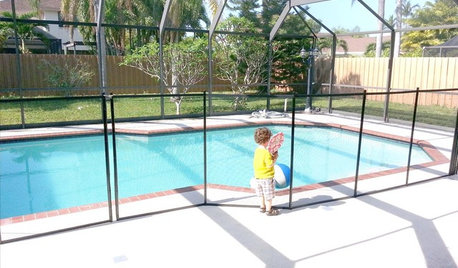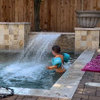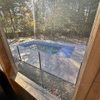Pool Suction & Entrapment Hazards
Suction and Entrapment Hazards - an
Underrated Risk
On Thursday, September 28, 2000 an 18 year old lifeguard was found dead in a splash pool at
the Hawaiian Water Adventure Park. He had been sucked into an intake pipe during
maintenance. This was not an isolated incident. In March 1994, a lifeguard was killed at the
Saanich Commonwealth Place in Saanich, BC. While working to repair a grate in the wave pool,
she became trapped underwater by the suction from the ten inch intake pipe for the pools
waterslide. A young girl died at a pool in Toronto after her hair became entangled in a
malfunctioning skimmer equalizer fitting. In New Jersey, a 16 year old girl died after being
trapped on the drain grate of a whirlpool. Other deaths and serious injuries have resulted as a
result of suction incidents at public and private aquatic facilities.
All aquatic facilities have a variety of fittings or fixtures which are potential suction or
entrapment hazards. These hazards are often not included in any regular inspection or risk
assessment process. The Lifesaving Society recommends that every facility implement a process
to identify all suction and entrapment hazards. After identification, steps should be taken to
eliminate or reduce the hazard and implement a schedule of regular inspections. The Lifesaving
Society recommends an inspection frequency of at least once a month.
Typical swimming pool suction hazards include: pool drains, skimmers, equalizer fittings,
vacuum fittings and intakes for water features such a slides. Many of the hazards exist in the pool
tank. Some will also be located in areas such as the surge tank, open filter tanks and wave
chambers. Entrapment hazards include fixtures which can entrap body parts such as hands, feet,
hair, etc.
Lifeguards and Pool Operators have an obligation to recognize these hazards and take steps to
prevent possible injuries or deaths. Effective prevention must address 3 areas of preventive
actions: design, pool operation practices and lifeguarding practices.
Drain and Skimmer Design
The highest risk pools for a suction incident are shallow pools such as wading pools or
whirlpools where the drain can be blocked by someone sitting on the drain or long hair can
become trapped in the drain. Pools with 2 separate bottom drains should not be able to cause the
suction problem. If one drain is blocked by a body, the other drain prevents the development of
dangerous suction forces. Other design solutions include sensors in the drain line which
automatically turn off the pump if the drain is blocked and installing emergency shut-off
switches beside the pool.
Many skimmers incorporate an equalizer fitting which is connected to the pool through the wall
below the skimmer opening. The purpose of the equalizer is to protect the pool pump by
providing a water supply if the water level drops below the skimmer opening. Unfortunately
these fittings can malfunction and generate suction even if the water level is above the skimmer
Page 2 of 2
opening. All equalizer fittings on skimmers should be disabled with a permanent plug inside the
skimmer.
Pool Operating Practices
Most pools draw water from the bottom drain and skimmers through a common line. The relative
draw from the skimmers versus the drain is adjusted by valves on each line. It is common
practice when a pool is open to bathers to draw 50 - 80% of the flow through the skimmers. This
practice reduces the probability of a suction injury involving the main drain.
Broken or improperly installed drain covers also increase the risk of injury. Every facility should
regularly inspect drain covers to determine if they are correctly installed and in good repair. All
drain covers should be securely fastened so that they cannot be moved or opened without the
appropriate tools. Any problems must be corrected immediately. If the drain cover is plastic, a
spare cover should be stocked at the pool.
Lifeguarding Practices
Lifeguards must regularly scan the pool bottom and be prepared to respond immediately if they
see a bather playing with the drain or who appears to be stuck on the drain. All pool staff must
know how and where to quickly turn off all pool pumps.
Lifeguards can also help prevent incidents by educating the public about dangerous behaviors.
Sitting on the pool drains of wading pools and whirlpools should be discouraged. In whirlpools
where bubbles compromise a lifeguardÂs ability to see the bottom, customers should be
prevented from submerging their heads in these pools.
By analyzing the design of the circulation system, examining operating practices and reviewing
lifeguarding practices, every facility can dramatically reduce the risk of suction injuries at their
pool.
Risks for Facility Staff
Lifeguards and their employers need to be aware of potential suction hazards in the facility: in
staff-only areas as well as public areas. Safety education to protect facility staff should include
the location of suction sources, shutoff procedures, equipment lockout procedures and confined
spaces procedures. In all cases, a buddy system should be part of the safety systems.
For more information about suction and entrapment hazards, contact the Lifesaving Society.
_____________________________
Published by the Lifesaving Society
11759 Groat Road, Edmonton, Alberta, Canada T5M 3K6
Phone: 780-415-1755; Fax: 780-427-9334
email: experts@lifesaving.org website: www.lifesaving.org









joanneswimsct
neilaz
Related Discussions
FYI-Sad story concerning swimming pool dangers
Q
Help Please on evaluating bid for a pool in Michigan
Q
Pool new build
Q
Building new pool in NJ
Q
Rack Etear
poolanalystOriginal Author
cascade
poolanalystOriginal Author
repair_guy
poolanalystOriginal Author
cascade
bberger
mikethepoolguy
just-a-pb